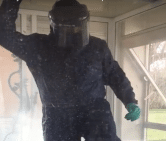The chemical industry uses highly toxic products which, when released, usually accidentally, can pose a serious threat to the on-site staff and then to first responders. After having defined the main toxic industrial chemicals, we will see how to protect against them.
The industrial chemical toxics are generally in the form of liquids associated with varying levels of saturated vapor or gas. They are similar to chemical warfare agents. The Polycombi® CBRN Protective suit presents an excellent protection against chemical warfare agents (HD, GD …). We tested it for its ability to protect against industrial products like hydrofluoric acid and chlorine and to resist a liquid projection of concentrated acid, sometimes intentionally used against law enforcement during demonstrations.
The industrial chemical toxics
Twenty-one chemicals have been identified by NATO and retained by France in the context of industrial chemical toxics. H. Delacour et al.
These include, for example, chlorine (used in the chemical industry and paper industry), ammonia (for the manufacture of fertilizers and fuels), carbon disulfide (used as a solvent), hydrocyanic acid (pesticides), nitric acid and sulfuric acid (for fertilizers), formaldehyde (intermediate product of the plastic industry). They are generally less toxic than war chemicals, more volatile and less persistent.
The threat
At the industrial level, these products are held in large quantities at the production and use sites. They can be transported by rail, road or sea, which represents an additional risk. An accident, an act of sabotage or terrorism is never to be ruled out and the consequences on man and/or his environment can be disastrous (Bhopal).
The Protection
PPE is essential for those who handle hazardous chemicals within chemical companies.
It is generally considered that there are 3 priorities for the protection: respiratory protection using filter cartridges, protection of the body extremities by wearing boots and gloves, and protection of the skin against gases and liquids.
In this article we will be interested only in the protection of the skin by using polycombi.
We tested the capabilities of the polycombi to protect the individual against two important chemicals, chlorine (Cl2) and hydrofluoric acid (HF).
Chlorine
Widely used in the chemical and paper industry, it is in the form of a greenish gas, heavier than air. Its smell is suffocating. It is also found in the disinfection industry. It irritates the respiratory and ocular mucous membranes with a risk of acute edema of the lungs and burns of the skin and the cornea. It is also a chemical warfare agent, used several times during the First World War and in the current conflicts in Syria and Iraq.
Hydrofluoric acid
It is used in mineral, metallurgical and chemical industries. Ceramics, glassware, crystal and metallurgy make extensive use of this product. It is a volatile liquid very irritating and smoking in the air. It intensely irritates the respiratory and ocular mucous membranes and causes caustic lesions on the skin.
The tests
A textile sample is put in a cell, a dose of gas is applied upstream and a gas flow is applied through the textile. The transfer of the substance is measured by its dosage on the other side of the textile. The experiment lasts 6 hours.
Chlorine
The cell measures 12.56 cm2, the RH and the temperature are controlled. The air flow through the fabric simulates a wind speed of 1 m/s. For a concentration of chlorine starting from 4 000 mg.min/m3, the three tests showed a transfer on the other side of the textile of less than 205 mg.min/m3 after 6 hours. Under these conditions, the penetrating dose is therefore only 5% of that initially set. This experiment shows the effectiveness of polycombi protection against chlorine gas.
Hydrofluoric acid
Under identical conditions, hydrofluoric acid applied at a dose of 4 000 mg.min/m3 for 6 hours is dosed at a level below the detection limit which corresponds to a dose of less than 30 mg.min/m3. Thus, it transfers less than 0.7% of HF after 6 hours under these experimental conditions. Protection is also very important here.
Concentrated Acid Projection Strength Test
Gutter test
37% concentrated hydrochloric acid is delivered via an inclined gutter at 45 °. A volume of 10 mL runs on a polycombi textile test specimen and on a hydro/oleo polyamide reference material. After 60 seconds, the textile of the polycombi has neither degradation nor absorption (first figure). On the other hand, the reference textile is destroyed in the casting zone of the acid (second figure). This clearly indicates that polycombi effectively protects against liquid sprays of concentrated acids.
Test for resistance to prolonged contact with acid
Textile samples are deposited in 20 mL of 37% concentrated acid. After 15 min the control textile is completely destroyed while the polycombi textile is intact showing that it is resistant to prolonged contact with the concentrated acid.
The photos were taken at T0, T1.5 min, T5min and T15 min. At the top the control textile and below that of the polycombi
Resistance to liquid vaporization penetration
Test methods for protective clothing for chemicals – Part 4: Determination of resistance to penetration by liquid spraying (mist test). Automatic back-up
Method B: high intensity mist test. The high-level mist test applies to garments with fog-tight seams between the different parts of the garment and, where appropriate, between clothing and other personal protective equipment that covers the entire body and Intended to be worn under conditions which present a risk of exposure to particles of liquid sprayed.
An individual wearing a polycombi performs motions under a spray of water colored with methylene blue. At the end of the experiment, he undressed and it was found that the white undergarment under his polycombi had no stain of methylene blue. Under these experimental conditions, polycombi is resistant to penetration by liquid vaporization (high intensity mist test).
The test can be viewed on the following video
Autor : Profesor François Renaud



